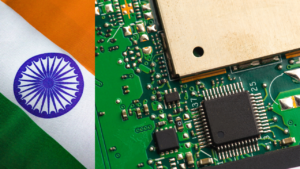Introduction
Electronics and semiconductor manufacturers in India are preparing for a monumental investment surge of Rs 3 trillion over the next five years. This ambitious move coincides with India’s domestic electronics market valued at $33 billion. Additionally, there is an export opportunity poised at nearly $30 billion. This investment aims to reshape India’s technological landscape significantly. This surge in investment is driven by both the country’s massive domestic demand for electronics, projected to reach $500 billion by 2030, and the potential for exports.
Let’s delve into the significance of this investment surge and its potential implications.
Follow us on Linkedin for everything around Semiconductors & AI
Background: India’s Growing Electronics Market
India has emerged as a significant player in the global electronics market. This growth is driven by robust domestic demand and increasing export opportunities. The Confederation of Indian Industry (CII) estimates India’s electronics market could reach $500 billion by 2030, highlighting immense growth potential.
In response, the government has introduced strategic initiatives to boost domestic manufacturing. These efforts aim to reduce dependency on imports and align with broader economic objectives.
Domestic Demand: The Indian market for electronics is expected to witness phenomenal growth, reaching a value of $500 billion by 2030 according to estimates by the Confederation of Indian Industry (CII). This massive domestic demand is a key motivator for the increased investments in the sector.
Government Incentives: The Indian government’s incentive schemes are playing a crucial role in attracting investments. For instance, the Rs 17,000 crore Production Linked Incentive (PLI) scheme for IT hardware has drawn in big players like Acer, Asus, Dell, HP and Lenovo, who have collectively committed to investments of about Rs 3,000 crore to manufacture devices like laptops, tablets and servers in India.
India’s Electronics Market: Why It Matters
Boost to Domestic Manufacturing: The Rs 3 trillion investment surge signifies a major commitment to bolstering India’s domestic manufacturing capabilities in electronics and semiconductors. This move will expect to create a robust ecosystem that not only meets local demand but also enhances export competitiveness on a global scale.
Job Creation and Economic Growth: The influx of investments is poised to generate substantial employment opportunities across various skill levels, from manufacturing to research and development. This will contribute significantly to economic growth, driving forward India’s agenda of becoming a manufacturing powerhouse.
Global Competitiveness: By scaling up production capacities and adopting advanced technologies, Indian firms aim to compete more effectively with global giants in the electronics and semiconductor sectors. This strategic investment will enhance India’s position in the global supply chain, fostering innovation and technological leadership.
Strategic Initiatives and Government Support: Government-led initiatives such as the Production-Linked Incentive (PLI) scheme for IT hardware and the Scheme for Promotion of Manufacturing of Electronic Components and Semiconductors (SPECS) have played a pivotal role in attracting investments. Continued support through policy frameworks and incentives will be crucial to sustaining momentum and fostering a conducive business environment.
Key Players and Investments in India’s Semiconductor Sector
The Indian semiconductor sector is witnessing a significant boost, driven by government incentives and a burgeoning domestic market. Here’s a breakdown of the key players and their investments:
Government Initiatives:
- Production Linked Incentive (PLI) Scheme: This scheme offers financial incentives for companies setting up manufacturing units in India. It has attracted major players in IT hardware like Acer, Asus, Dell, HP, and Lenovo, leading to investments of about Rs 3,000 crore for manufacturing laptops, tablets, and servers.
Established Indian Players:
- Tata Group: Partnering with Taiwan’s Powerchip Semiconductor Manufacturing Corp (PSMC), Tata Group is spearheading the development of India’s first semiconductor fabrication unit (fab). This signifies a massive investment in domestic chip production. News about the specific investment amount is still emerging, but it’s expected to be substantial.
Multinational Giants:
- Micron Technology: This US-based semiconductor giant signed a Memorandum of Understanding (MoU) with the Gujarat government to establish a $2.75 billion semiconductor manufacturing unit in the state. This signifies a major foreign investment in Indian chip manufacturing.
Read More: 7 Exciting Technology Products From CES 2024 – techovedas
Challenges and Opportunities
While the outlook appears promising, sustaining momentum will require addressing several challenges:
- Infrastructure Development: Enhancing infrastructure capabilities, including logistics and power supply, is crucial to supporting large-scale manufacturing operations.
- Skill Development: Investing in skill development programs to meet the evolving needs of the electronics and semiconductor industries will be essential.
- Global Market Dynamics: Navigating global trade dynamics and geopolitical factors will be critical for maintaining competitiveness in international markets.
Read More: 6 Reasons Why Nvidia Overtook Apple as World’s Second Most Valuable Company – techovedas
Conclusion
India’s pursuit of a Rs 3 trillion investment surge in electronics and semiconductors is transformative. The country has robust market potential and strategic investments from key players.
India aims to strengthen its position in the global electronics supply chain. These investments promise to catalyze economic growth and foster innovation. They will create a thriving ecosystem for technology and manufacturing in India.
Ref: Financial Times








